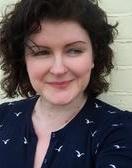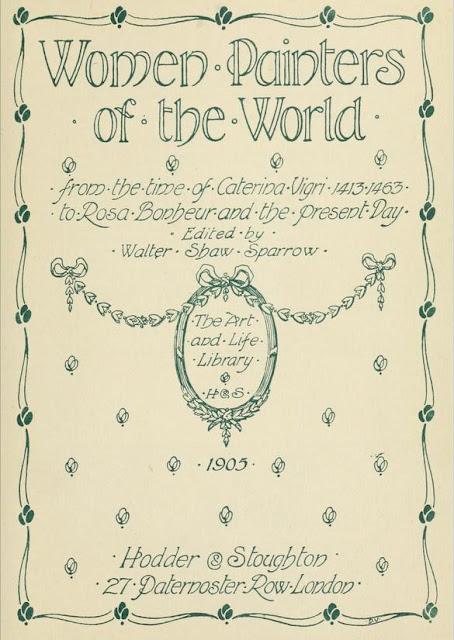
This did not cost me very much money from eBay and in fact can be downloaded for free from Archive.org, which is my favorite price of all. Anyway, all this rambling leads me to this picture, which is the frontispiece...
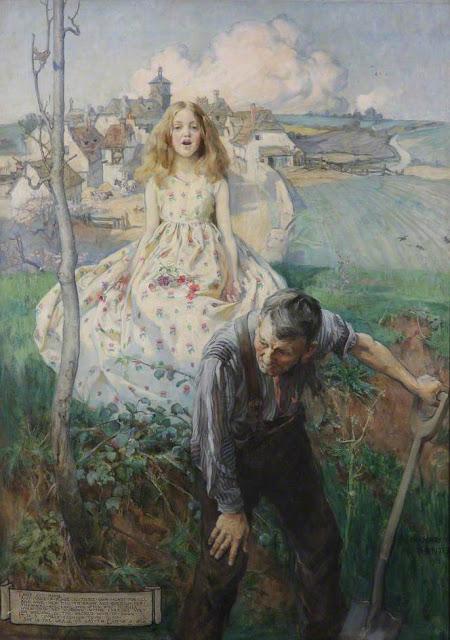
Joy and the Labourer (1901) Mary Young Hunter
The little scroll at the bottom reads:TAKE JOY HOMEAND MAKE A PLACE IN THINE OWN HEART FOR HERAND GIVE HER TIME TO GROW AND CHERISH HER!THEN WILL SHE COME AND OFTEN SING TO THEEWHEN THOU ART WORKING IN THE FURROWS! AY,OR WEEDING IN THE SACRED HOUR OF DAWN.IT IS A COMELY FASHION TO BE GLADJOY IS THE GRACE WE SAY TO GOD
This verse came from The Christian Science Journal in 1898 and obviously inspired Mary Young Hunter to create the tabeau of Joy, as a little singing girl, warbling to the working man in his furrow. He might look beaten and exhausted but he has taken time to nurture joy as he tends to his land (or the land of others) and so his work won't break him. It is a very joyous picture indeed and the little girl reminds me of my beautiful niece when she was younger. The Christian sentiment behind it has overtones of 'working class people get their rewards in heaven' which is all very Victorian, but I also get a hint that there is a little bit of that working chap that will remain forever his, that he has a reserve of strength that he needs to cope with how bloody awful life can be. I might be reading too much into this but I would go on to say that the verse and picture are saying that working people have the ability to nurture joy and know God in the way that the feckless, idle rich do not because they do not know how to grow and nurture. That might link back to the whole camels and eyes of needles business, but I digress. Mary Young Hunter was not in Girl Gang (when I write a sequel, she might well appear) but I was left wondering who on earth could have painted such a strange image. As it turns out, the journey takes us from New Zealand to Hollywood via the Clyde...
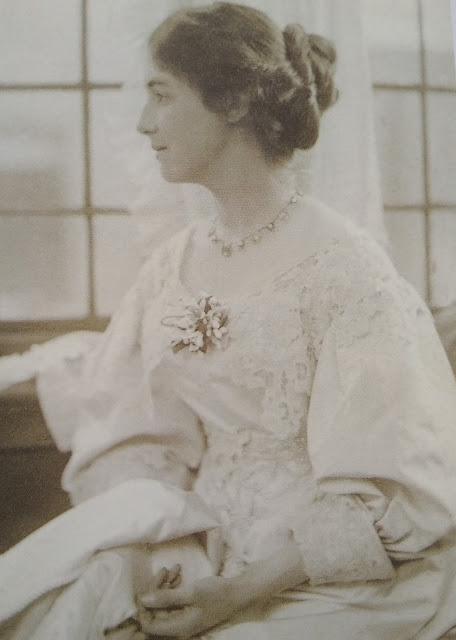
Mary, c.1899
Starting in New Zealand, Mary Towgood (as she was in the beginning) was born in Napier in the Spring of 1872. Her father, Edward was from Glamorgan in Wales, where his father had been a solicitor. What inspired Edward to become a sheep farmer in New Zealand isn't exactly clear, but then it's what the Lamprey family do in Surfeit of Lampreys by Ngaio Marsh, so it must have been a viable option for those with money. Edward married Edith Tylee, a Napier girl, in 1869 and their four daughters arrived speedily afterwards. Eldest daughter Edith Ethel was born six months after their marriage (I'm saying nothing), followed by Mary in 1872, Alice in 1874 and Stephanie in 1877. However, their sheep-filled happiness was short lived, as Edward died in 1882, aged only 45. It is unclear whether or not the family had returned at that point as some report his death in London, others in New Zealand and others in Wales. Whatever the location, in the later 1880s, Edith and her young daughters found themselves in England.
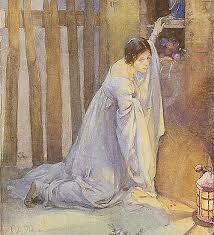
The Shrine (early 1900s) Mary Young Hunter
In a newspaper interview many years later, Mary claimed to have been too young when she left New Zealand to remember anything but her departure from Wellington - the purple half circle of hills and the waves crashing on the shore at Napier. Seeing as she was 10 when her father died, the journey must have come fairly hard on the heels of that, or else the circumstances around their departure were so traumatic as to obliterate all that came before. Young Mary found herself at school in Bath, followed by a few years on the continent, finishing her education before returning to London to start art school.
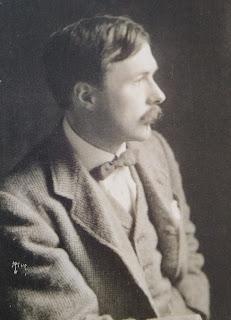
John Young Hunter, 1899
Mary found herself at the South Kensington Cope and Nichol School of Painting in Pelham Street, a place known for preparing young artists for the Royal Academy. On to the Royal Academy Miss Towgood duly went, and Mary did exceptionally well, coming away with four medals, including one for a model of a bust from life in 1895. She also met John Young Hunter, a Glaswegian artist obsessed with the Wild West...
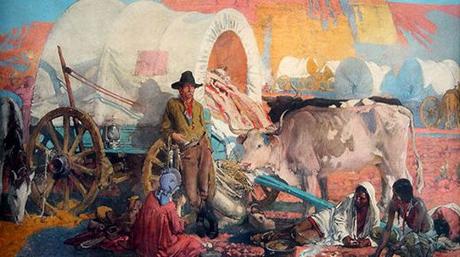
The Old Santa Fe Trail (c.1920) John Young Hunter
John was the son of Colin Hunter, a Scottish seascape artist and close friend of John Singer Sargent. Colin called his eldest daughter 'Colina' which is magnificent because he had two sons to pass his name on to but no, his daughter got it. The family lived on Melbury Road, with neighbours like Marcus Stone and Frederic Leighton, in a very arty part of society indeed. Apparently Colin debated with friends whether it was better to send John to Paris or to the Royal Academy for his artistic training. The RA won out and it was probably at this impressionable age that John saw the Buffalo Bill Wild West show and it had a profound effect on him, leading to things like this...
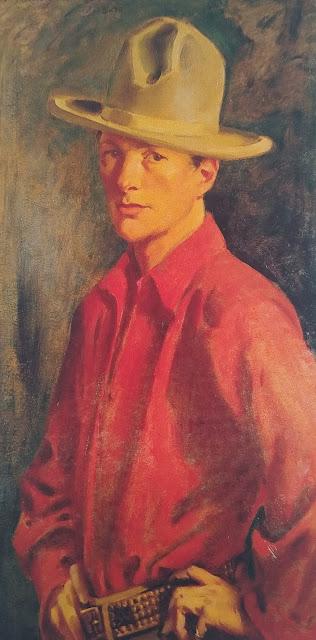
Self Portrait No.1 (1920) John Young Hunter
Well, there you go. Anyway, all that is still in the future as to begin with John and Mary were both devoted to more romantic schools of art. When they married in 1899, Mary took John's middle name as part of her name, become Mary Young Hunter. The couple traveled to Florence where they had a studio and then returned to England via Germany and Belgium. On their return the couple finally settled at Giffords Hall in Suffolk (now a vineyard!) where they lived from 1903 to 1909. The building itself provided inspiration to the couple as this tender portrait of Mary by John shows...
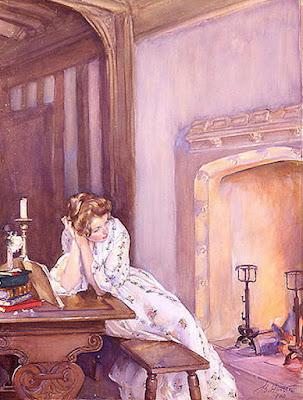
Musings by Giffords' Fireside (1903) John Young Hunter
When 'The Studio' hailed the couple as 'new Pre-Raphaelites', it was not hard to see why as they had risen to fame swiftly with some beautiful and familiar works...
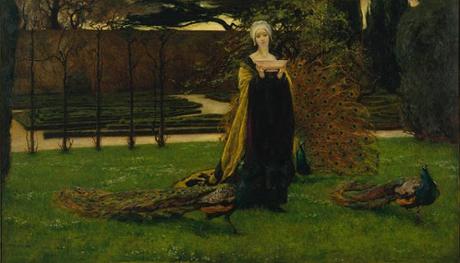
My Lady's Garden (1899) John Young Hunter
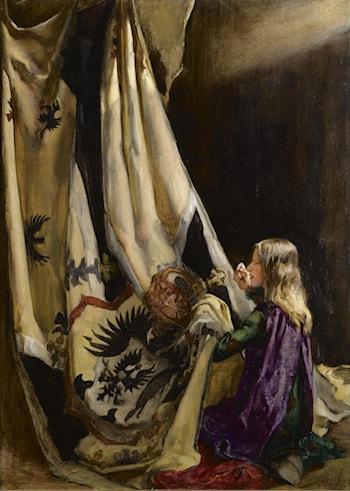
The Flagmender (c.1900) John Young Hunter
John's work was grand and dense in color and pattern where as Mary's seems airy by comparison...
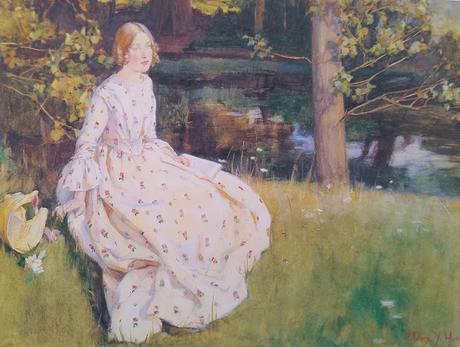
Dreaming by a Pond (1903) Mary Young Hunter
Mind you, that's not to say she couldn't be deep...
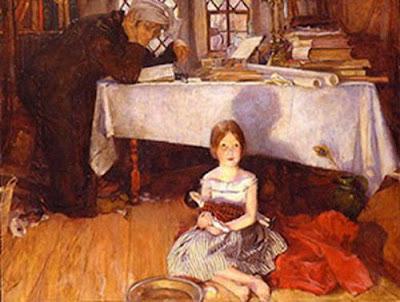
Seekers: 'Where shall Wisdom be Found?' (1902) Mary Young Hunter
I love a 'problem' picture and this one reminded me of this one by Oswald Moser...
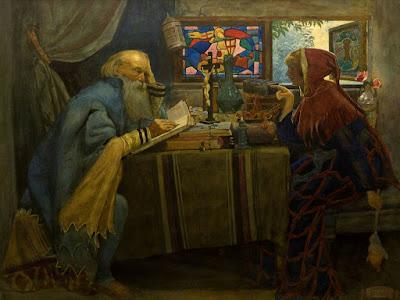
Folly and Learning Often Dwell Together (no date) Oswald Moser
Mary's picture asks which of the two figures do you think has grasped wisdom? Spoiler alert, it's obviously the bare-footed poppet on the floor as she has avoided the endless battle of not having enough bookcases by avoiding that whole reading business altogether. While Moser's picture post-dates Mary's (and might have been inspired by it, as it was a very popular image, reproduced in the Christmas edition of The Graphic), there are a few of Mary's paintings which seem to draw the wellspring of their inspiration from the Pre-Raphaelites and their followers.
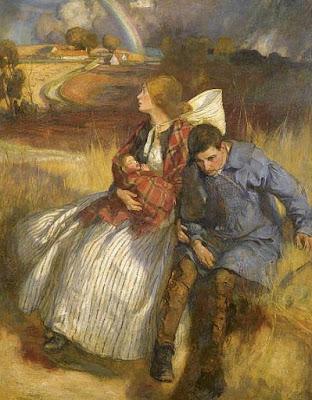
The Bow in the Cloud (1906) Mary Young Hunter
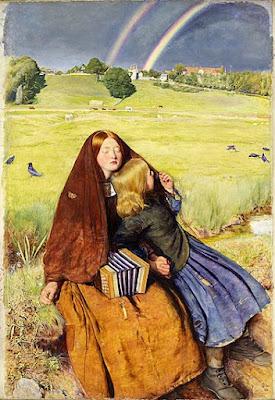
The Blind Girl (1856) John Everett Millais
Okay, it's not a mystery where Mary took inspiration for her picture, but I noticed in the very splendid Pyms Gallery catalog on the Young Hunters from 2000 also cited this picture too...
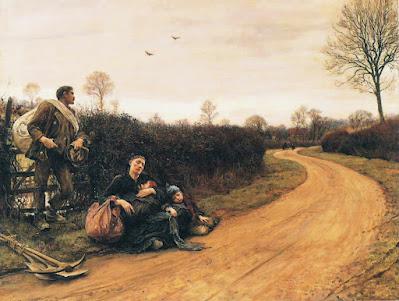
Hard Times (1886) Hubert von Herkomer
While Herkomer's family is realist, Mary's mother is looking towards the rainbow as if acknowledging a sign from God. For Herkomer's group there is a long road ahead, but for Mary's, the clouds have parted and peace and better times have broken out. Then there is this...
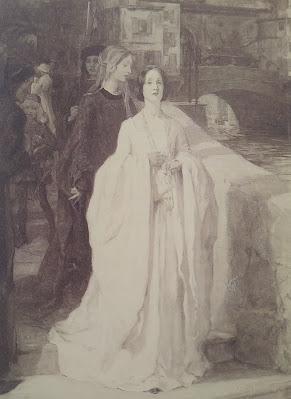
The Denial (1901) Mary Young Hunter
Her rendition of the meeting between Dante and Beatrice is very reminiscent of predecessors such as...
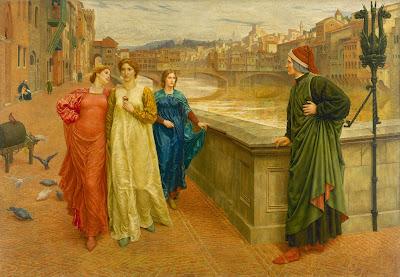
Dante and Beatrice (1883) Henry Holiday
Holiday wanted his depiction of the scene to be accurate, and so traveled to Florence for research and so I wonder if Mary did likewise while she was in Italy. Her figure of Beatrice was much admired in the newspapers, with The Scotsman reporting 'None would say her Beatrice clothed in white samite walking by the side of the Arno with her attendant maidens and guard is not a sufficiently dignified and haughty personage.' I'm sure that was what she was going for...
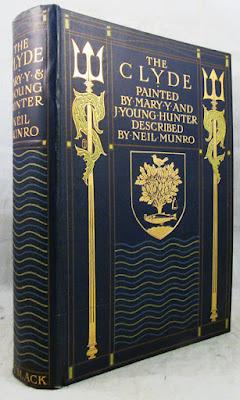
The couple's daughter Gabrielle was born in 1905 but this did not seem to slow down Mary's industry. In 1907, the couple collaborated on the book The Clyde, producing illustrations for descriptions by Neil Munroe, but increasingly Mary began to seek out children to paint, possible inspired by Gabrielle. One of her most famous images from this period also harks back to an earlier piece...
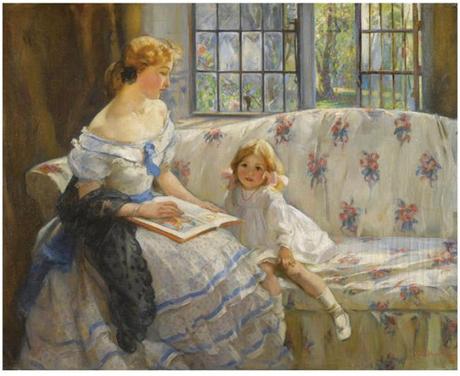
Once Upon a Time (1909) Mary Young Hunter
I was instantly reminded of this...
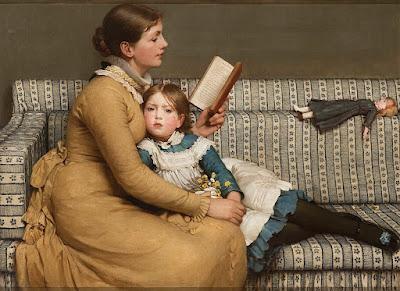
Alice in Wonderland (1879) George Leslie Dunlop
Despite being a settled family of painters, Mary and John still traveled. After an introduction from Colin Hunter's friend Singer Sargent, Mary became friends with Alice and Claude Monet and the group traveled to Venice, despite Monet being in a bad mood because everything was too beautiful. I wonder if the couple's travels are a hint that they were not truly settled in England, so when they sailed to America in 1913 it was not a surprise. They were sailing away as successful and respected artists, as John had great success in 1912 Royal Academy exhibition with Vanity Fair (even though many magazine's puzzlingly listed it as by Mary...)
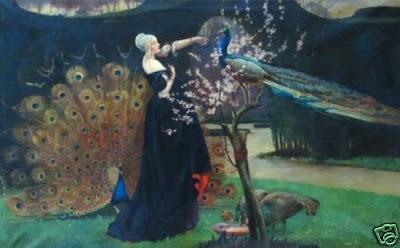
Vanity Fair (1911) John Young Hunter
According to a biography of Mabel Dodge Luhan, a wealthy art patron in Taos, New Mexico, the couple arrived in Taos and looked to settle in a place that had no artistic preconceptions for them. They had traveled around North America, exhibiting in places such as Minneapolis in 1916, and staying for a while in New York where John kept a studio for the rest of his life, but possibly the heat and artistic community of New Mexico drew them south. They bought a piece of land next to Mabel's and built a double studio for John (now 'Jack' to his America friends it seems) and Mary, with two bedrooms above. They worked on the building of the house themselves, bringing in Native American workmen, who fascinated John and possibly even modelled for his new 'Western' art. John's new art found a ready audience looking for romantic images of the Wild West, and his paintings such as The Old Santa Fe Trail became railway posters for the Santa Fe Railway Company. Mary increasingly seemed defined by her images of little girls and in a Country Life article on the couple, she was referred to as a painter of children, but 'no less accomplished in her portraiture if their elders'. On the couple's visits to England, Mary received commissions of some fairly influential subjects...
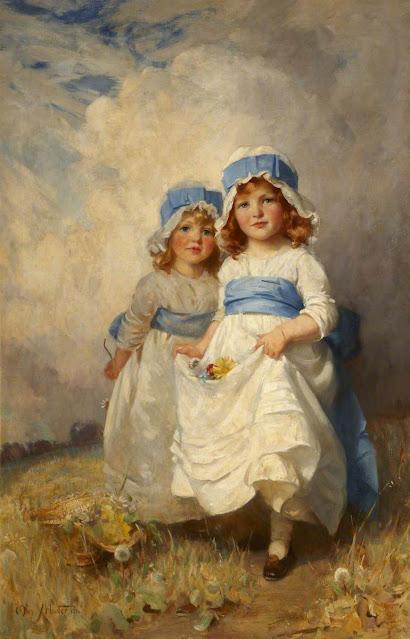
Little Moppets!
The winsome pair above are Lady Margaret Frances Ann Vane-Tempest-Stewart and her sister Lady helen Maglona Vane-Tempest-Stewart, painted in 1914. This is so very Victorian, with obvious reference to Millais's moppet pictures and back further to Joshua Reynold's work. Compare this with Phyllis, produced in tempera, gold leaf on gesso panels in the late 1920s...

Phyllis (c.1929) Mary Young Hunter
So what had occasioned this change in style? Unfortunately, after building their studio house in Taos, John began to romance Mabel Dodge Luhan's secretary, Eve Renz Schroeer and divorced Mary. When he wrote his memoir, Reviewing the Years, he neglected to mention Mary or Gabrielle. His transformation into a new American artist was complete. All contact between the couple seems to have broken down and when, later in life, Mary attempted to contact John to work on one final piece of art together, a portrait of their grandchild, Eve apparently blocked it.

Clair (c.1929) Mary Young Hunter
Although she kept ties with the community at Taos, Mary moved to Carmel in California. Gabrielle had married young and then divorcedin the early 1920s, only to meet Edward Kuster, a musician and patron of the arts in Carmel. According to her very touching obituary in the Carmel Pine Cone newspaper after her death in 1978, Gabrielle had been visiting her mother with her son 'Shim', and fell in love with both Carmel and Mr Kuster, remaining in the community to create the Theatre of the Golden Bough.
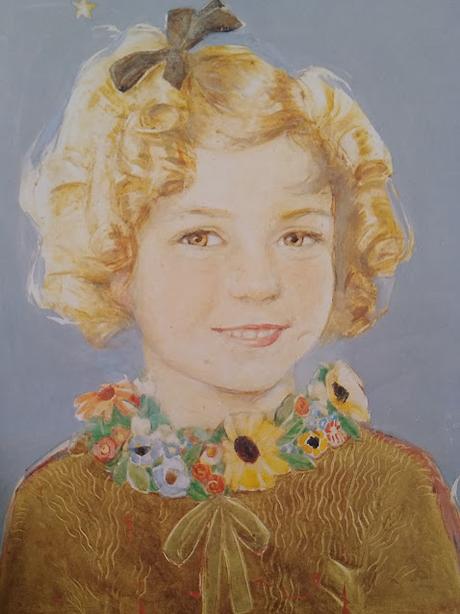
Shirley Temple (1935-8) Mary Young Hunter
Mary Hunter Young lived her life quietly by the sea in California, writing children's book which have seemingly slipped into obscurity. It is therefore appropriate that the woman so often dismissed as a children's portraitist should create a portrait of one of the most famous children of the 20th century. Although it would be hard to say 'Shirley Temple' and 'Pre-Raphaelite' in the same sentence, this work in tempera manages to join the tempera revival artists of the Pre-Raphaelite following all the way to works like this one by Peter Blake, one of the Ruralists who were in turn inspired by the Pre-Raphaelites...
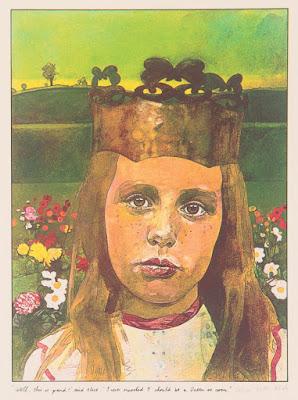
Alice in Wonderland (1970) Peter Blake
Mary died in Carmel in 1947, and after the death of her husband in 1961, Gabrielle came to live in her mother's beautiful yellow purpose-built house and lived out her life as a bright light in her Californian home.
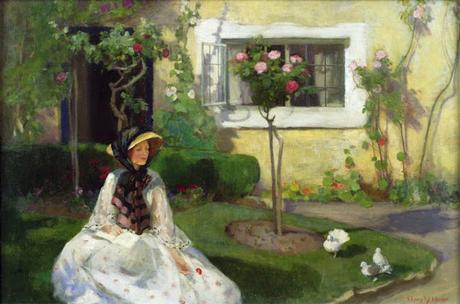
A Quiet Moment (early 1900s) Mary Young Hunter
If we take into account the body of work that Mary Young Hunter left, her connection with Monet and Shirley Temple, her books, her use of tempera on the cusp of the revival in America in the 1930s and her startlingly beautiful early works, why do we not know her better? I promise I won't end every post with the words 'Let's have a retrospective!' but blimey, she is well overdue.
